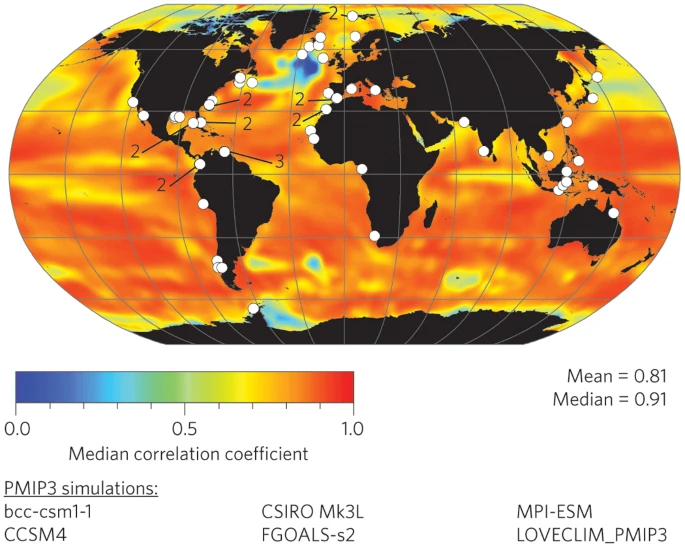- Home
- Science Introduction
- Wg
- 2k Network
- Phase 2 Databases
- Regional and Continental Temperature Compilations
- Ocean2K
- Ocean2k Low-resolution Global Synthesis Dataset (2015)
Ocean2k Low-resolution Global Synthesis dataset (2015)
Current version: V1.0
> Access publication
> Access data (NOAA)
Citation details Helen V. McGregor, Michael N. Evans, Hugues Goosse, Guillaume Leduc, Belen Martrat, Jason A. Addison, P. Graham Mortyn, Delia W. Oppo, Marit-Solveig Seidenkrantz, Marie-Alexandrine Sicre, Steven J. Phipps, Kandasamy Selvaraj, Kaustubh Thirumalai, Helena L. Filipsson, and Vasile Ersek. 2015. Robust global ocean cooling trend for the pre-industrial Common Era. Nature Geoscience. . doi: 10.1038/NGEO2510
Summary of Database
The Ocean2k Synthesis dataset is a global synthesis of marine based sea surface temperature (SST) reconstructions for the common era (0-2000CE). A total of 57 individual marine reconstructions were used, mostly along the ocean basin edges (Figure. A). To be included in the compilation, records had to meet the following criteria:
- Data is from a marine archive, is peer-reviewed and publicly archived.
- Has a minimum sample resolution of 1 observation per every 200years, span atleast two consecutive 200year bins.
- Contains at least two age dates between 200 before the common era (BCE), and 2015CE.
- The timeseries is a SST reconstruction, and not included in the Ocean2k “high Resolution” Synthesis ( Tierney et al., 2015).
Upon inclusion into the synthesis, records were placed into 200 year bins and standardised. Analysis with this dataset found a robust cooling trend from 1-1800CE, and is compared to other terrestrial reconstructions for the same period. Further detail on the results of this, and the details of the synthesis data can be found in the publication ( McGregor et al., 2015). Metadata for each record used in the synthesis is included in the supplementary section, and this includes information about the site of each record, the proxy type and seasonality, and calibration and sampling resolution information. Links to the original data products and publications are also included, along with a short comment section describing any record specific nuances that need to be recorded.

Figure. A: A map showing the records used in this study, overlaying a map based on six climate model simulations for 801-1800CE. Further information on the methods used to create the map can be found in the data descriptor publication( McGregor et al (2015)).
How to access database:
The database archived long term on WDS Paleo, and the study page can be accessed via the button below, or at the top of the page. The study page contains all citation and metadata information, as well as a data folder for downloading the data itself. To access the data, navigate to the study page, scroll down to the “Download Data” table, and choose the file that best suits your needs. The contents of this data folder are summarized in the table below. Metadata for the datasets can be found in the excel data files, as well as in the supplementary of the original publication.
| file/folder | Description |
|---|---|
| Excel Data File | A .xlsx file of the synthesis dataset for download. The file includes input metadata, source URLs, footnotes, and the data matrix |
| CSV Text Data File | A .csv file of the synthesis dataset data matrix for download |
| Zip Code File | A compressed .zip folder containing both files above, matlab code to produce composites from supplementary Figure 1A and Figure 2A of McGregor et al (2015), all composite outputs of the matlab code, and a readme directory file with instructions for running the code. |
Want to get involved with the PAGES2k Network?
This project has concluded, however new projects are occurring with the current PAGES2k Working groups. Visit the PAGES2k Network main page to view current working groups, contact project leaders, or join the mailing list. For information about the development of the CoralHydro2k Coral database, see the CoralHydro2k main page.